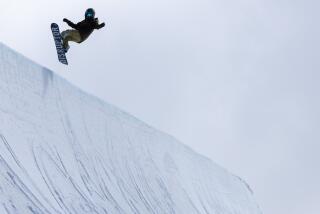For Happy Trails, Exercise Caution : Study shows injuries are a given for mountain bikers, but slowing down and wearing helmets can lessen the severity. Riding downhill causes most injuries.
The word is in on mountain bike riders: Yes, they do get hurt, but usually not too seriously, thanks to the widespread use of helmets.
That’s according to a study published this month in the Western Journal of Medicine. In a mail survey of 268 members of all-terrain bicycling clubs in Los Angeles and San Diego, 84% of the respondents reported they had suffered injuries on their mountain bikes, half of them in the previous year. A quarter of those hurt needed to see a doctor, and 4.4% were admitted to a hospital.
The authors of the report said the results suggest that mountain bikers have more injuries than road cyclists, but the injuries are not necessarily more severe. The study found that 86% of mountain cyclists routinely wear helmets, compared to 57% of road riders.
Of course, one thing that mountain bikers avoid by riding on trails and fire roads is vehicle traffic. Statistics show that, by far, most bicycle deaths involve collisions with automobiles, as in the deaths last weekend of two riders from South Orange County, who were hit by a pickup truck while riding on Interstate 70 in Utah.
Three-fourths of the injuries to mountain bike riders happened while they were riding downhill. The most common factors cited include excessive speed (36%), unfamiliar terrain (35%), inattentiveness (23%) and riding beyond ability levels (20%).
“Crashing is just a thing that is going to happen,” said Eric Rumbin, a competitive mountain bike rider from Irvine.
Among Rumbin’s list of personal injuries are a concussion, a broken nose, scrapes and bruises. One accident resulted from a flat tire; another happened when Rumbin’s wheel got caught in a rut in the trail.
“It’s a given thing, that eventually you will sustain an injury,” said Pat Follett, co-owner of Team Big Bear Mountain Bike Center at Snow Summit, a popular weekend destination for local mountain bikers and the top mountain bike race center in Southern California. The center will host the National Offroad Bicycling Assn. national finals next year.
*
The center requires all riders to wear helmets and stations first-aid personnel along the track during races. Still, injuries sometimes happen. Although most are merely “rashes” (scrapes and cuts), there are some broken collarbones and, on rare occasions, more serious injuries.
At a race earlier this month at Snow Summit, a 26-year-old rider from Sunnyvale suffered serious head and back injuries during a practice downhill run. Follett said it was the most serious injury suffered at the mountain bike center. Typically, races that include hundreds of riders result in no more than a few bumps, cuts and scrapes.
Follett has seen an increasing interest in downhill racing at his center, with downhill registration for a typical amateur race almost doubling since last summer (he attributes the rise to the growing popularity of mountain bike suspension). The center has expanded hours for practice runs.
Recently, a downhill racer at Mammoth Mountain set a speed record of 59 m.p.h. Snow Summit, because the runs are not as long, tends to favor more “technical” courses with more turns, which results in lower speeds and, consequently, fewer accidents caused by speed.
El Moro Canyon in Crystal Cove State Park is probably the most popular spot for recreational mountain bike riders in Orange County. Mike Starkweather, lifeguard supervisor for the park, said that on a typical weekday afternoon as many as 100 cars may crowd the parking lot, usually with several cyclists per car.
The terrain in Crystal Cove is steep, which inevitably leads to speed-related accidents.
“Yes, there are injuries. Yes, there are people who get hurt,” said Starkweather. Injuries raise liability concerns for the state, but Starkweather said there is little the park can do: “Analyzing everyone’s personal skill level (before they enter the park) is impossible.”
The good news, Starkweather said, is that serious injuries “have really declined, in my analysis. We haven’t landed a Lifeflight (medical evacuation helicopter) in some time.” He attributes the decline in injuries to better equipment and, perhaps most of all, to the volunteer group Share.
Share riders patrol the park and help make sure cyclists obey speed regulations and other guidelines. “They really help in governing the use here,” Starkweather said.
Ironically, Starkweather and others said it is often the more experienced riders who sustain injuries. Beginning riders tend to be cautious; some more competitive riders get hurt trying to push themselves to the next skill level.
“You try to go faster and just end up crashing,” said Rumbin, who works at the Bike Source, a mountain bike shop in Irvine, in addition to racing competitively. He’s heard lots of war stories and knows of people who have sustained serious injuries, but they were riding without the single most essential piece of equipment.
“I’ve never seen a serious head injury with a helmet,” said Rumbin, who never rides without head protection.
In addition to helmets, gloves are recommended (most riders tend to put their hands out in a fall). Beyond that, to avoid injury riders should keep their equipment in good working order, control speed and be familiar with the terrain. Finally, bikers should know their capabilities and ride within them.
“Mountain bikers should be aware of the high risk of injury,” said Tony Chow, chief author of the study released this month. In addition to being an emergency room physician at Loma Linda University Medical Center, Chow is a mountain biker.
Co-authors of the study were Mark Bracker of UC San Diego and Kevin Patrick of UCSD and San Diego State University.
More to Read
Sign up for Essential California
The most important California stories and recommendations in your inbox every morning.
You may occasionally receive promotional content from the Los Angeles Times.










